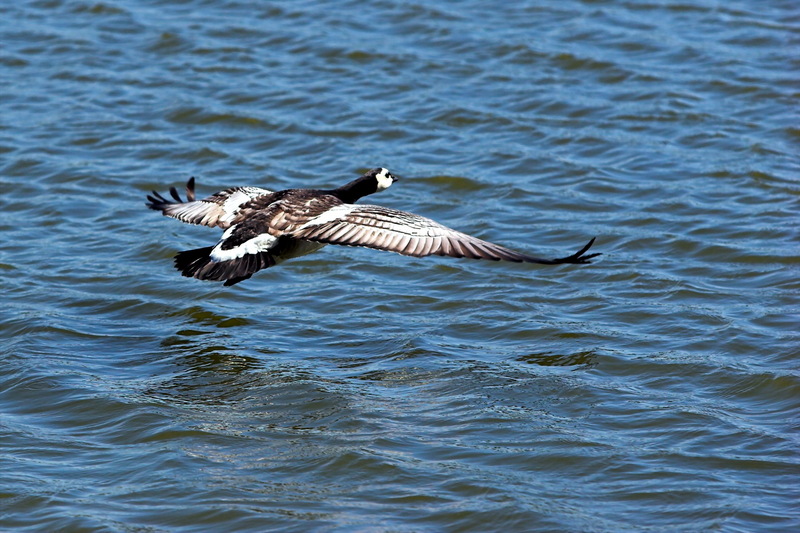Barnacle Goose
From Wikipedia, the free encyclopedia
[Photo] Branta Leucopsis in flight. Photo by Thermos.
The Barnacle Goose (Branta leucopsis) belongs to the genus Branta of black geese, which contains species with largely black plumage, distinguishing them from the grey Anser species. Despite its superficial outward similarity to the Brent Goose, genetic analysis has shown it is an eastern derivative of the Cackling Goose lineage.
Anatomy and morphology
The Barnacle Goose is a medium-sized goose with a white face and black head, neck, and upper breast. Its belly is white. The wings and its back are silver-gray with black-and-white bars. During flight a V-shaped white rump patch and the silver-gray underwing linings are visible.
Distribution
Barnacle Geese breed mainly on the Arctic islands of the North Atlantic. There are three main populations, with separate breeding and wintering ranges; from west to east:
- Breeding in eastern Greenland, wintering on the Hebrides of western Scotland and in western Ireland. Population about 40,000.
- Breeding on Svalbard, wintering on the Solway Firth on the England/Scotland border. Population about 24,000.
- Breeding on Novaya Zemlya, wintering in the Netherlands. Population about 130,000.
- A new fourth population, derived from the Novaya Zemlya population, has become established since 1975 breeding on the Baltic Sea islands (Estonia, Finland, Denmark, and Sweden), and wintering in the Netherlands. Population about 8,000.
Small numbers of feral birds, derived from escapes from zoo collections, also breed in several other north European countries. Occasionally, a wild bird will appear in the Northeastern United States or Canada, but care must be taken to separate out wild birds from escaped individuals, as Barnacle Geese are popular waterfowl with collectors.
Ecology, behavior and life history
Barnacle Geese frequently build their nests high on mountain cliffs; away from predators (primarily Arctic Foxes and Polar Bears) but also away from food. Like all geese, the goslings are not fed by the adults. Instead of bringing food to the newly hatched goslings, the goslings are brought to the ground. It was once thought that adults carried the young down to the ground but the truth is far more difficult to imagine.
Unable to fly, the three day old goslings jump off the cliff and fall; their small size, feathery down, and very light weight helps to protect some of them from serious injury when they hit the rocks below, but many die from the awful impacts they experience on the way down and upon final landing. To complicate matters, arctic foxes are attracted by the noise made by the parent geese during this time and capture many dead or injured goslings. The foxes also stalk the young as they are led by the parents nearly one-half mile across a meadow to nearby wetland feeding areas. This spectacle is one of the most bizarre and disturbing in nature and a testament to the will to survive.
Its call is a "kaw".
Conservation
The Barnacle Goose is one of the species to which the Agreement on the Conservation of African-Eurasian Migratory Waterbirds (AEWA) applies.
Importance to humans
In Mythology
The English name of this species, and the scientific name of the Brent Goose (B. bernicla) and the Goose Barnacle, come from the old fable that Barnacle Geese were produced from barnacles, organisms that grow on timber exposed to salt water. This belief stemmed from the observation that these geese were never seen in summer, when they were supposedly developing underwater (they were actually breeding in remote Arctic regions). The barnacles and the geese shared similar black and white colours, plus a certain type of barnacle looked - with a bit of imagination - like a tiny black and white goose. The geese and the barnacles appeared in different seasons. The legend was also convenient, because it enabled Catholics to classify these geese as fish and therefore to eat their flesh during Lent.
http://en.wikipedia.org/wiki/Barnacle_Goose
| The text in this page is based on the copyrighted Wikipedia article shown in above URL. It is used under the GNU Free Documentation License. You may redistribute it, verbatim or modified, providing that you comply with the terms of the GFDL. |
|

